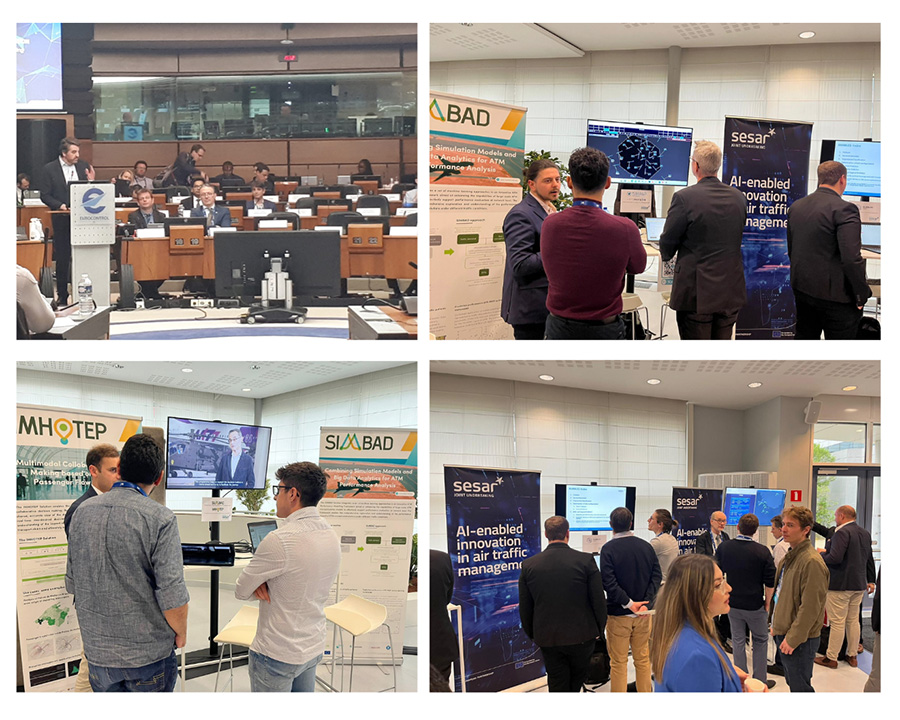On 20-21 April, FLY AI partners* organised a two-day conference to explore the latest developments and deployments of artificial intelligence (AI) and machine learning (ML) in aviation. Hosted by FLY AI partner, EUROCONTROL, the conference included updates from the European Commission on AI regulatory matters, the discussion of practical-use cases of AI benefits to aviation, an exhibition of projects and success stories, the exploration of the FLY AI digitalised catalogue of applications, and an overview of ongoing research and training activities.
Several SESAR projects participated in the exhibition presenting a range of AI applications. Involved in the exhibition were SESAR 2020 projects BUBBLES, MAHALO, ARTIMATION, ISOBAR, HAAWAII, IMHOTEP and SIMBAD.
The exploratory research project BUBBLES developed AI-based algorithms to compute the collision risk of UAS leading to separation minima and methods so that a target level of safety (TLS), stated in terms of overall probability of collision, can be defined and maintained.
The MAHALO project developed a hybrid machine learning (ML) system composed of layered deep learning and reinforcement learning models, trained on controller performance, strategies, and physiological data. It learned to solve ATC conflicts and, coupled with enhanced en-route traffic conflict detection and resolution (CD&R) prototype display, and it presented machine rationales for the ML output.
The ARTIMATION project addressed challenges related to transparency of automated systems in air traffic management using explainable AI (XAI). It proposed tools which aim to improve explainability through AI algorithms based on data-driven storytelling and immersive analytics with the purpose of assessing the effectiveness of different visualisation techniques.
The ISOBAR project prototyped a user-driven mitigation plan that takes into account airspace user priorities, weather-related changes in demand, ATFCM regulations, flow constraints, and network effects. Finally, it developed an operational and technical roadmap for the integration of ancillaries into the Network Manager platform by defining interfaces, and functional and performance requirements.
The HAAWAII project developed a generic architecture based on machine learning for automatic speech recognition understanding (ASRU) applications in air traffic management. The project developed an ASRU tool capable of reducing the additional clicking time by a factor of 30. The free cognitive controller resources can help to reduce flight time and fuel use in the terminal environment.
The IMHOTEP project provided a comprehensive view of the door-to-door passenger trajectory through coherent integration of different types of high-resolution passenger movement data. This enabled the development and integration of predictive models capable of anticipating the evolution of the passenger flows within the terminal and the ground transport system.
The SIMBAD project developed and evaluated a set of machine learning approaches aimed at enhancing the capabilities of large-scale airspace management microsimulation models to effectively support performance evaluation at the network level.
In addition to the projects exhibiting, a session took place, moderated by Alain Siebert,regarding the regulation and implementation of Artificial Intelligence. With participation from major stakeholders such as Antoine-Alexandre Andre, European Commission; Patrick Bezombes, CEN CENELEC; Anna Von Groote, EUROCAE; and Romaric Redon, AIRBUS, the session provided an update on the ongoing regulatory and standardisation development in the domain of AI and data in Europe and its relevance to the aviation sector. Within this session, AIRBUS highlighted how AI regulation and standardisation developments will impact a wide range of activities while focusing on the need to develop novel TrustworthyAI methods to have efficient means of compliance.
In case you missed the event, you can access the playback of both days here.
For more information on developments and innovations in artificial intelligence check out the CORDIS results pack on AI in air Traffic management brochure here.
*European Commission, SESAR 3 JU, EASA, ACI Europe, Airbus, ASD, CANSO, EDA, Heathrow Airport, Honeywell, IATA, IFATCA, IFATSEA, NATO, Thales and led by EUROCONTROL

